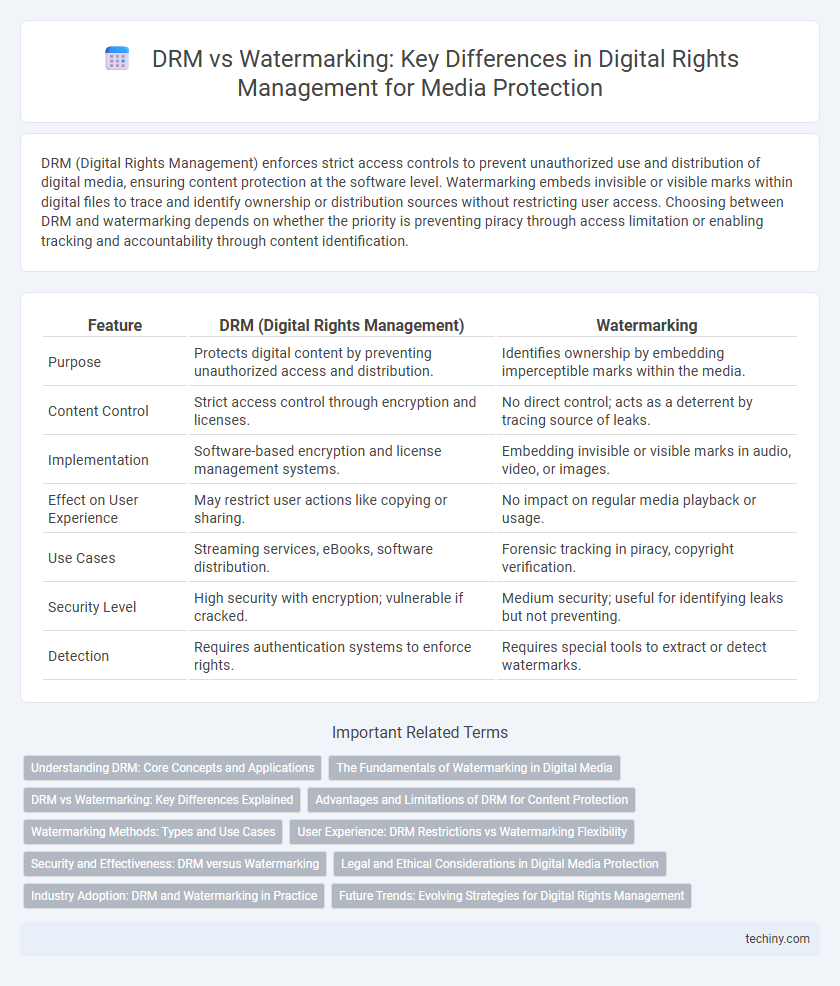DRM (Digital Rights Management) enforces strict access controls to prevent unauthorized use and distribution of digital media, ensuring content protection at the software level. Watermarking embeds invisible or visible marks within digital files to trace and identify ownership or distribution sources without restricting user access. Choosing between DRM and watermarking depends on whether the priority is preventing piracy through access limitation or enabling tracking and accountability through content identification.
Table of Comparison
| Feature | DRM (Digital Rights Management) | Watermarking |
|---|---|---|
| Purpose | Protects digital content by preventing unauthorized access and distribution. | Identifies ownership by embedding imperceptible marks within the media. |
| Content Control | Strict access control through encryption and licenses. | No direct control; acts as a deterrent by tracing source of leaks. |
| Implementation | Software-based encryption and license management systems. | Embedding invisible or visible marks in audio, video, or images. |
| Effect on User Experience | May restrict user actions like copying or sharing. | No impact on regular media playback or usage. |
| Use Cases | Streaming services, eBooks, software distribution. | Forensic tracking in piracy, copyright verification. |
| Security Level | High security with encryption; vulnerable if cracked. | Medium security; useful for identifying leaks but not preventing. |
| Detection | Requires authentication systems to enforce rights. | Requires special tools to extract or detect watermarks. |
Understanding DRM: Core Concepts and Applications
Digital Rights Management (DRM) involves technological controls that restrict the unauthorized use, distribution, and copying of digital media content, ensuring copyright protection and revenue security for creators and distributors. Watermarking, by contrast, embeds identifiable information within the media itself to trace piracy but does not prevent unauthorized access. DRM systems integrate encryption, user authentication, and licensing protocols, making them essential for managing digital content rights across platforms and devices.
The Fundamentals of Watermarking in Digital Media
Watermarking in digital media embeds imperceptible, unique identifiers directly into audio, video, or images to assert ownership and track distribution without affecting user experience. This technique differs from DRM by offering a passive protection method that doesn't restrict content access but enables content authentication and copyright enforcement. Effective watermarking uses robust algorithms to resist tampering and unauthorized removal, ensuring continuous traceability across various platforms and formats.
DRM vs Watermarking: Key Differences Explained
DRM (Digital Rights Management) controls access and usage of digital content through encryption and licensing, preventing unauthorized distribution and copying. Watermarking embeds invisible or visible markers within the media to track ownership and detect piracy without restricting use. While DRM enforces permissions, watermarking serves as a forensic tool to identify content leaks and attribute responsibility.
Advantages and Limitations of DRM for Content Protection
DRM (Digital Rights Management) enforces strict control over digital content by restricting unauthorized access, copying, and distribution, making it highly effective for protecting intellectual property. However, DRM systems often face limitations such as compatibility issues across devices, potential impact on user experience, and challenges in balancing security with consumer rights. Compared to watermarking, which provides passive traceability, DRM offers active enforcement but requires ongoing management and technological updates to remain effective.
Watermarking Methods: Types and Use Cases
Watermarking methods in digital media include visible, invisible, robust, and fragile watermarks, each serving different purposes such as copyright protection, content authentication, and piracy tracking. Visible watermarks deter unauthorized use by displaying logos or text on images and videos, while invisible watermarks embed data imperceptibly for forensic tracing and usage monitoring. Robust watermarking withstands compression and editing, making it ideal for broadcast content, whereas fragile watermarking detects tampering in sensitive digital documents.
User Experience: DRM Restrictions vs Watermarking Flexibility
DRM imposes strict access controls and usage limitations on digital content, often disrupting user experience through device restrictions, frequent authentication, and limited sharing options. Watermarking offers a more flexible approach by embedding invisible or visible marks that trace content origin without hindering playback or usability, preserving seamless access for legitimate users. The balance between robust protection and user convenience makes watermarking favorable for enhancing customer satisfaction while maintaining digital media integrity.
Security and Effectiveness: DRM versus Watermarking
DRM (Digital Rights Management) provides robust security by controlling access and usage permissions to digital media, effectively preventing unauthorized distribution and copying. Watermarking enhances content protection by embedding invisible or visible marks that trace ownership and identify leaks, but it does not restrict access directly. While DRM offers proactive enforcement of digital rights, watermarking serves as a reactive forensic tool for tracking and deterring illegal distribution.
Legal and Ethical Considerations in Digital Media Protection
Digital Rights Management (DRM) enforces usage restrictions on digital content through technological controls, raising legal debates on user rights and fair use under copyright law. Watermarking embeds identifiable information into media files, facilitating ownership tracking without limiting access, thus posing fewer ethical concerns about user freedom. Both methods balance intellectual property protection with consumer rights, demanding careful consideration of privacy laws, copyright infringement penalties, and ethical standards in digital media distribution.
Industry Adoption: DRM and Watermarking in Practice
DRM technology is widely adopted across industries such as streaming services, gaming, and eBooks to prevent unauthorized access and distribution of digital content. Watermarking is utilized predominantly in video production, broadcasting, and publishing to trace and identify content leaks without restricting user access. Both techniques often complement each other, with DRM enforcing access controls and watermarking providing forensic tracking to enhance overall digital content protection.
Future Trends: Evolving Strategies for Digital Rights Management
Future trends in digital rights management emphasize the integration of AI-driven DRM systems with sophisticated watermarking techniques to create adaptive and resilient content protection. Blockchain technology is becoming increasingly influential, enabling transparent and decentralized rights verification combined with dynamic watermark embedding for traceability. These evolving strategies aim to balance robust piracy prevention with seamless user experience across digital media platforms.
DRM (Digital Rights Management) vs Watermarking Infographic

 techiny.com
techiny.com